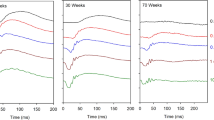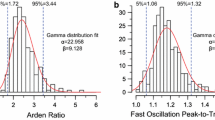Abstract
Changes in the ERG and VEP across the life span were investigated. The dark adapted and scotopic ERGs both showed a progressive increase in the implicit times of the A and B waves and a reduction in the amplitude of the AB configuration. There was also an increase in the implicit times of the oscillatory potentials of the photopic ERG.
The flash and pattern onset-offset VEP both showed changes in waveform with age whilst the waveform of the pattern reversal VEP was constant. The amplitudes of the components of the flash and pattern reversal VEP were very high in the teenage group, but once reduced, were constant from the twenties onwards, showing no further consistent age changes.
The latencies of the components of the pattern VEPs showed an increase with age which could be accounted for by the reduction in retinal illuminance due to the decrease in pupil diameter with age. However, the increase in the latency of the flash major positive (P2) component was greater than that expected from the decrease in retinal illuminance alone, suggesting that this is due to neural factors.
Similar content being viewed by others
References
Allison T, Goff WR and Wood CC (1979) Auditory, somatosensory and visual evoked potentials in the diagnosis of neuropathology: Recording considerations and normative data. In: Lehmann D, Callaway E, eds. Human evoked potentials - applications and problems. New York, Plenum Press p 1–16
Allison T, Wood CC and Goff WR (1983) Brainstem auditory, pattern reversal visual, and short latency somatosensory evoked potentials: latencies in relation to age, sex and brain and body size. Electroenceph Clin Neurophysiol 55:619–636
Arden GB, Carter RM, Hogg C, Siegel IM and Margolis S (1979) A gold foil electrode: extending the horizons for clinical electroretinography. Invest Ophthal 18:421–426
Asselman P, Chadwick DW and Marsden CD (1975) Visual evoked responses in the diagnosis and management of patients suspected of multiple sclerosis. Brain 98: 261–282
Buchsbaum MS, Henkin RI and Christiansen RL (1974) Age and sex differences in averaged evoked responses in a normal population with observations on patients with gonadal dysgenesis. Electroenceph Clin Neurophysiol 37:137–144
Celesia GG and Daly RF (1979) Effects of aging on visual evoked responses. Arch Neurol 34:403–407
Copenhaver RM and Perry NW (1964) Factors affecting visually evoked cortical potentials such as impaired vision of varying etiology. Invest Ophthal 3:665–673
Cosi V, Vitelli E, Gozzoli L, Corona A, Ceroni M and Callieco R (1982) Visual evoked potentials in aging of the brain. In: Courjon J, Mauguiere F, Revol M, eds. Clinical applications of evoked potentials in neurology. New York, Raven Press, pp 109–115
Creutzfeldt OD and Kuhnt U (1967) The visual evoked potential: physiological, developmental and clinical aspects. Electroenceph Clin Neurophysiol: 26 (Suppl):29–41
Drasdo N (1976) A method of eliciting pattern specific responses and other electrophysiological signals in human subjects. Brit J Physiol Opt 31:14–22
Dustman RE and Beck EC (1966) Visually evoked potentials: amplitude changes with age. Science 151:1013–1015
Dustman RE and Beck EC (1969) The effects of maturation and aging on the waveform of visually evoked potentials. Electroenceph Clin Neurophysiol 26:2–11
Dustman RE, Schenkenberg T, Lewis EG and Beck EC (1977) The cerebral evoked potential: Life span changes and twin studies in man: Desmedt JE, ed. Visual evoked potentials in man. Oxford, Clarendon Press, pp 363–377
Halliday AM (1980) Event related potentials and their diagnostic usefulness. In: Kornhuber HH, Deecke L, eds. Motivation, motor and sensory processes of the brain. Progress in Brain Research, Vol 54. Amsterdam, Elsevier/North Holland Biomedical Press, pp 470–485
Halliday AM, Barrett G, Carroll W and Kriss A (1982) Problems in defining the normal limits of the visual evoked potential. In: Courjon J, Mauguiere F, Revol M, eds. Clinical applications of evoked potentials in neurology. New York, Raven Press, pp 1–10
Halliday AM, McDonald WI and Mushin J (1973) Delayed pattern evoked responses in optic neuritis in relation to visual acuity. Trans Ophthal Soc UK 93:315–324
Harding GFA, Doggett CE, Orwin A and Smith EJ (1981) Visual evoked potentials in pre-senile dementia. In: Spekreijse H and Apkarian PA, eds Docum Ophthal Proc Ser 27:193–202
Harding GFA, Williams DE and Innes JA (1984) The visual evoked response and visual psychophysics during Ethambutol therapy In: Proc. 2nd Evoked Potentials Symposium, London, Butterworth (In Press).
Jeffreys DA (1977) The physiological significance of pattern visual evoked potentials. In: Desmedt JE, ed. Visual evoked potentials in man: new developments. Oxford, Clarendon Press, pp. 134–167
Karpe G, Rickenbach K and Thomasson S (1950) The clinical electroretinogram. 1. The normal electroretinogram above fifty years of age. Acta Ophthal 28:301–305
Keppel G (1973) Design and analysis: A researchers handbook. Englewood Clifts N.J., Prentice Hall
Kinney JAS (1977) Transient visually evoked potential. J Opt Soc Amer 67:1465–1474
Kooi KAand Bagchi BK (1964) Visual evoked responses in man: normative data. Ann N Y Acad Sci 112:254–269
Martin DA and Heckenlively JR (1982) The normal electroretinogram Docum Ophthal Proc Ser 31:135–144
Peterson H (1968) The normal B-potential in the single flash clinical electroretinogram. Acta Ophthal Suppl 99:5
Shaw NA and Cant B (1981) Age dependent changes in the amplitude of the pattern visual evoked potential. Electroenceph Clin Neurophysiol 51:671–673
Snyder EW, Dustman RE and Shearer PE (1981) Pattern reversal evoked potential amplitude: Life span changes. Electroenceph Clin Neurophysiol 52:429–434
Sokol S, Moskowitz Aand Towle VL (1981) Age related changes in the latency of the visual evoked potential: influence of check size. Electroenceph Clin Neurophysiol 51:559–562
Spekreijse H, Van der Tweel LH and Zuidema TH (1973) Contrast evoked responses in man. Vision Res 13:1577–1601
Stockard JJ, Hughes JF and Sharborough FW (1979) Visually evoked potentials to electronic pattern reversal: latency variations with gender age and technical factors. Amer J EEG Technol 19:171–204
Straub W (1961) Einige Erkrankungen des Sehnerven in electroretinographischer Sicht. Vision Res 1:220–227
Vainio-Mattilo B (1951) The clinical electroretinogram: The difference between the electroretinogram in men and women. Acta Ophthal 29:25–32
Van der Tweel LH, Estevez O and Cavonius CR (1979) Invariance of the contrast evoked potential with changes in retinal illuminance. Vision Res 19:1283–1287
Vries-Khoe LH de and Spekreijse H (1982) Maturation of luminance and pattern EPs in man. Docum Ophthal Proc Ser 31:461–475
Weleber RG (1981) The effect of age on human cone and rod Ganzfeld electroretinograms. Invest Ophthal 20:392–399
Williams DE (1983) The effect on visual electrophysiological investigations of substances primarily inducing a deleterious effect on the retinal ganglion cells and/or higher up in the visual pathway. Unpublished PhD thesis. The University of Aston in Birmingham, England.
Wright CE and Drasdo N (1985) The influence of age on the spatial and temporal contrast sensitivity function. Docum Ophthal 59:385–395
Wright CE, Drasdo, N and Harding GFA (1984a) Electrophysiological and psychophysical studies on suspected unilateral retrobulbar neuritis. Transactions of the 1st International congress of the British College of Ophthalmic Opticians, Vol 1, pp 69–93
Wright CE, Harding GFA and Orwin A (1984b) Pre-senile dementia - the use of the flash and pattern VEP in diagnosis. Electroenceph Clin Neurophysiol 57:405–415
Zeidler I (1959) The clinical electroretinogram. The normal ERG value of the B potential in different age groups and its differences in men and women. Acta Ophthal 37:294–301
Zetterstrom B (1956) Studies on the postnatal development of the electroretinogram in newborn infants. Stockholm, Karolinska Sjukuset
Author information
Authors and Affiliations
Rights and permissions
About this article
Cite this article
Wright, C.E., Williams, D.E., Drasdo, N. et al. The influence of age on the electroretinogram and visual evoked potential. Doc Ophthalmol 59, 365–384 (1985). https://doi.org/10.1007/BF00159171
Issue Date:
DOI: https://doi.org/10.1007/BF00159171




